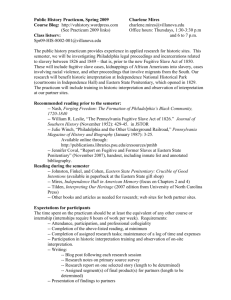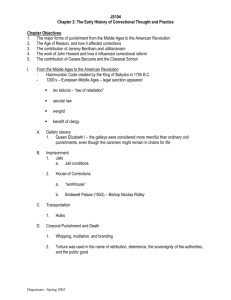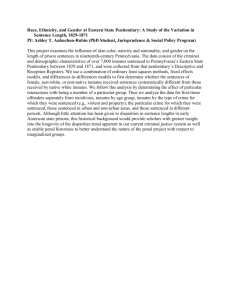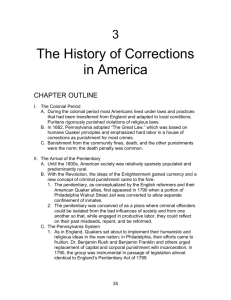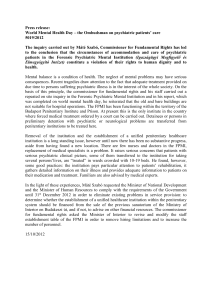Historiographic Essay
advertisement
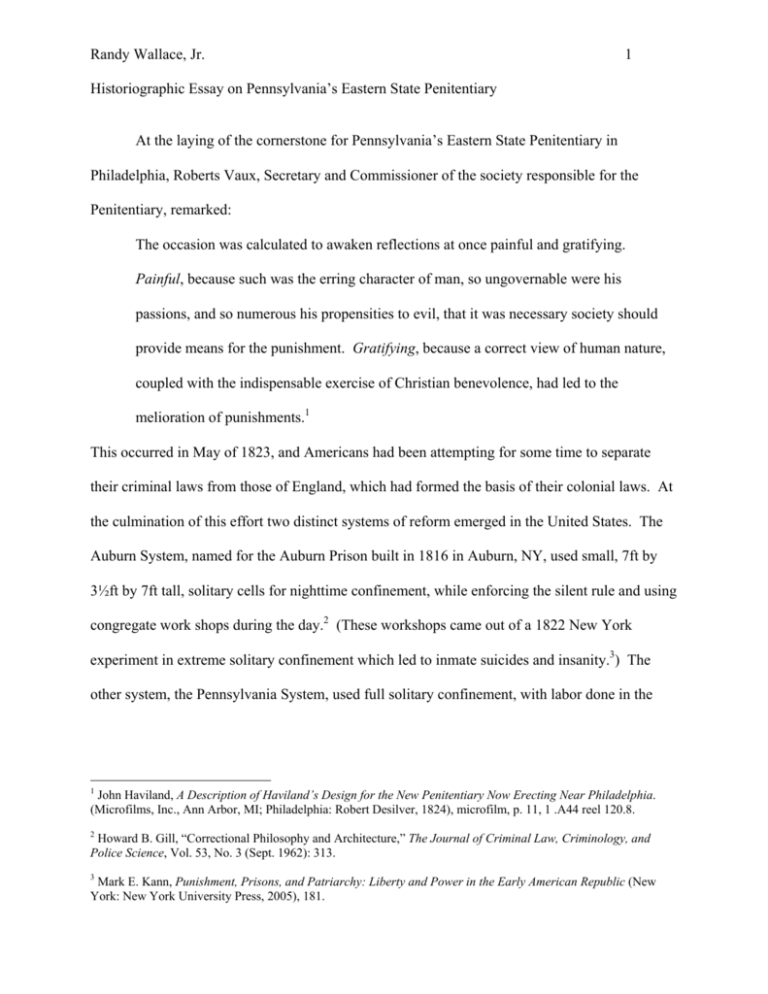
Randy Wallace, Jr. 1 Historiographic Essay on Pennsylvania’s Eastern State Penitentiary At the laying of the cornerstone for Pennsylvania’s Eastern State Penitentiary in Philadelphia, Roberts Vaux, Secretary and Commissioner of the society responsible for the Penitentiary, remarked: The occasion was calculated to awaken reflections at once painful and gratifying. Painful, because such was the erring character of man, so ungovernable were his passions, and so numerous his propensities to evil, that it was necessary society should provide means for the punishment. Gratifying, because a correct view of human nature, coupled with the indispensable exercise of Christian benevolence, had led to the melioration of punishments.1 This occurred in May of 1823, and Americans had been attempting for some time to separate their criminal laws from those of England, which had formed the basis of their colonial laws. At the culmination of this effort two distinct systems of reform emerged in the United States. The Auburn System, named for the Auburn Prison built in 1816 in Auburn, NY, used small, 7ft by 3½ft by 7ft tall, solitary cells for nighttime confinement, while enforcing the silent rule and using congregate work shops during the day.2 (These workshops came out of a 1822 New York experiment in extreme solitary confinement which led to inmate suicides and insanity.3) The other system, the Pennsylvania System, used full solitary confinement, with labor done in the 1 John Haviland, A Description of Haviland’s Design for the New Penitentiary Now Erecting Near Philadelphia. (Microfilms, Inc., Ann Arbor, MI; Philadelphia: Robert Desilver, 1824), microfilm, p. 11, 1 .A44 reel 120.8. 2 Howard B. Gill, “Correctional Philosophy and Architecture,” The Journal of Criminal Law, Criminology, and Police Science, Vol. 53, No. 3 (Sept. 1962): 313. 3 Mark E. Kann, Punishment, Prisons, and Patriarchy: Liberty and Power in the Early American Republic (New York: New York University Press, 2005), 181. Randy Wallace, Jr. 2 Historiographic Essay on Pennsylvania’s Eastern State Penitentiary cells. With the construction of the Eastern Penitentiary in the 1820s, Pennsylvania had a model prison to carry out their system. Even before the Penitentiary was completed in 1825, many articles and books had been written about it, both for and against the system. The passionate writings of the Boston Society in particular, against the use of prolonged solitary confinement, have been cited as the reason that the Penitentiary was not occupied until 1829.4 After the prison was in operation, many European countries sent representatives to observe, and several writings were made of the new Penitentiary, most in support of it. The most famous of these was written by Charles Dickens, who visited Philadelphia, and subsequently published his essay, “Philadelphia and Its Solitary Prison,” in 1842. Although most scholars seem hung up on his analysis of the system as “rigid, strict, and hopeless solitary confinement,” which he believes, “in its effects to be cruel and wrong,” a significant portion of his essay commends the intent of the system as being “kind, humane, and meant for reformation.”5 He even acknowledges the unique architecture of the building, and says that “it cannot be praised too highly.”6 This speaks of the unique panopticon form that John Haviland, architect of the Penitentiary, chose for its “strength, convenience, health, economy, and other desirable properties.”7 In Haviland’s obituary, published in 1832, his unknown biographer credits the sources for the panopticon, citing: “The earliest attempts of this 4 Orlando F. Lewis, Ph.D., The Development of American Prisons and Prison Customs, 1776-1845 (New York: Prison Association of New York, 1922; reprint, Montclair, NJ: Patterson Smith, 1967), 121 (page citations are to the reprint edition). 5 Charles Dickens, “Philadelphia and Its Solitary Prison,” American Notes, 1842; reprinted in The American Poetry Review, Vol. 33, No. 6 (Nov./Dec. 2004): 15. 6 Dickens, 15. 7 Haviland, 3. Randy Wallace, Jr. 3 Historiographic Essay on Pennsylvania’s Eastern State Penitentiary plan were made in Horsham, Petworth, and Gloucester, in England.”8 Noting that Haviland spent much of his life in England and had only recently moved to Philadelphia before the construction of the Penitentiary, the common argument that his design was original seems unfounded. The obituary continues to explain the spread of Haviland’s panopticon in Europe, and even offers a translated letter from the French architect M. Blouet as evidence, although the Pennsylvania system failed to spread in the U.S. The most prophetic and meaningful thought comes from the idea that: “The last point gained is seen; but the starting point, the point from which it is gained, is forgotten.”9 This offers a decent explanation for the oversight, and an explanation for later events. The purpose of this paper is to look at the more recent studies of the Penitentiary, focusing on the writings that have been made over the last eighty years or so, to show the surprising trend that these studies represent, and to offer an explanation for this trend. Through the works represented, the vast diversity of people interested in the building, as well as the architect, should show the wide-spread attention that the subject has received. Starting in the 1920s, the studies done on the Penitentiary seem thorough, complete, and inquisitive. In 1922, The Development of American Prisons and Prison Customs, 1776-1845 by Orlando Lewis, Ph.D. was published. In it he gives a thorough analysis of the American prison system immediately before the American Revolution, and carries it through many of the modern prison movements. He achieves this by first giving a broad description of the events in the U.S. which led to the prison reform movement, then shifting his focus to look at individual states and 8 “Obituary Notice of John Haviland, ESQ.,” Philadelphia, 1832; from the Journal of Prison Discipline, The Philadelphia Society for Alleviating the Miseries of Public Prisons, Vol. VII (7) (July, 1852): 7. 9 “Obituary Notice of John Haviland, ESQ.,” 6. Randy Wallace, Jr. 4 Historiographic Essay on Pennsylvania’s Eastern State Penitentiary their specific actions. In Pennsylvania, he takes a quick look at the Western State Penitentiary, designed by William Strickland, which had to be demolished soon after its construction. His only motive in looking at the Western Penitentiary is in showing the expenditure that the state authorized, an incredible $200,000.10 He claims that this prison “had no significance in the prison reform movement, save to point out a glaring and very expensive mistake.”11 He offers it now as a reason for the State to back the much more expensive Eastern Penitentiary; a way to remove the black mark of the Western. He continues his detailed analysis, and admits that the Eastern Penitentiary is “a developed imitation of earlier English prison plans.”12 The complete picture is soon given, for not only is a description of the prison and explanations for some questioned aspects of it provided, but also the reports made by the commissioners who visited the Penitentiary from England, Prussia, Russia, France, and Canada13 are used to describe the typical life that a prisoner could expect, all the way down to an exhaustive inventory of the prisoners’ cells. It is important to note that Dr. Lewis was uniquely qualified for such an undertaking; he had studied in the U.S., France, and Germany, as well as having served as the General Secretary of the Prison Association of New York for the last twelve years of his life. Although he died before the book was completed, and some chapters are left incomplete, it was published, and has been recognized as “one of fundamental importance to the history of American correction.” 10 Lewis, 120. 11 Lewis, 120. 12 Lewis, 120. 13 Lewis, 217. Randy Wallace, Jr. 5 Historiographic Essay on Pennsylvania’s Eastern State Penitentiary Also in that year, Harry Elmer Barnes, a historian and sociologist, published an article, “The Progress of American Penology as Exemplified by the Experience of the State of Pennsylvania, 1830-1920.” In this article, he argues that “the major aspects of progress in penological methods” have been achieved only since 1830.14 He centers his argument on the “commutation of sentences for good behavior,”15 and argues that the Eastern Penitentiary was unyielding, citing reports given by its inspectors which claim that their objection to the law was due to the additional labor of compiling individual records.16 Their other main objection was that: It was but an expedient devised by administrators of congregate prisons to lessen the difficulty of maintaining discipline in so defective a system. It was entirely superfluous in so perfect a system as that in operation in the Eastern Penitentiary.17 Although the author presents this evidence with obvious sarcasm, the citing of it does add some validity to its claim, and shows that the debate between the two systems was most likely embroiled in every matter of prison reform. During the 1930s, a few articles came out concerning prison architecture. Robert L. Davison’s 1931 “Prison Architecture” does not give any mention to the Eastern Penitentiary, nor to any specific prison for that matter, yet somehow concludes that “prison design is so backwards” that the “architect who begins by visiting existing jails simply clutters his mind and 14 Harry Elmer Barnes, “The Progress of American Penology as Exemplified by the Experience of the State of Pennsylvania, 1830-1920.” Journal of the American Institute of Criminal Law and Criminology, Vol. 13, No. 2 (Aug. 1922): 170. 15 Barnes, 170. 16 Barnes, 172. 17 Barnes, 173. Randy Wallace, Jr. 6 Historiographic Essay on Pennsylvania’s Eastern State Penitentiary inhibits his imagination.”18 This article is only offered as a basis of comparison for the book published in 1936, by Blake McKelvey, Ph.D., American Prisons: A Study in American Social History Prior to 1915. The book begins before the American Revolution, describing the makeshift jails that existed in the 1760s, and takes the reader all the way to the modern prisons of 1915. Concerning the Eastern Penitentiary, he gives a good description and says that “Pennsylvania was perfecting the solitary system and winning the plaudits of European visitors.”19 He comments on the Reverend Louis Dwight, a critic of the Pennsylvania System, who, although many of his astounding claims were never substantiated,20 met little resistance, in no small part due to the $750,000 price tag of the Eastern Penitentiary.21 He continues to give a reasonable explanation for why the prison style did not spread far in the U.S., as opposed to its contagious effect in European countries, citing the visits to the Penitentiary for turning England in 1835, Belgium in 1838, Sweden in 1840, and Norway and Holland in 1851,22 to an adoption of the solitary system for their new penitentiaries. The Europeans concluded that the Pennsylvania System produced better men, while the Auburn System produced better citizens.23 The author finishes with some thought on the current state of prisons (where more than one prisoner was being placed in a cell), and concludes that “if two convicts were to be housed in a 18 Robert L. Davison, “Prison Architecture,” Annals of the American Academy of Political and Social Science, Vol. 157 (Sept. 1931): 33. 19 Blake McKelvey, Ph.D., American Prisons: A Study in American Social History Prior to 1915 (Chicago: University of Chicago Press; Reprint, Montclair, NJ: Patterson Smith, 1968), 11 (page citations are to the reprint edition). 20 McKelvey, 19. 21 McKelvey, 11. 22 McKelvey, 16. 23 McKelvey, 17. Randy Wallace, Jr. 7 Historiographic Essay on Pennsylvania’s Eastern State Penitentiary cell, certainly they could live more comfortably under such an arrangement at Cherry Hill (Eastern Penitentiary) than anywhere else in the country.”24 By the 1950s, the studies of the Eastern Penitentiary had taken the predictable turn seen by Waterman and others as early as the 1930s. Robert C. Smith’s “Two Centuries of Philadelphia Architecture,” published in Transactions of the American Philosophical Society in 1953 took a solely aesthetic approach to its analysis of the prison: The best example of Gothic Revival is in the Eastern Penitentiary, begun by John Haviland in 1853, whose massively handsome stone walls still encase the system of radiating, spoke-like wings that established a new form of prison architecture.25 Concentrating solely on the architecture of the prison, however, many important actions that led to the prison are forgotten. This artistic approach would be given another interesting example in 1955, when Albert Ten Eyck Gardner sought an explanation for the prison’s appearance in an 1828 portrait of John Haviland that came to be in the possession of New York’s Metropolitan Museum of Art. Being an archivist for the museum, Gardner seeks to qualify the building “not only as Haviland’s masterpiece, or Philadelphia’s masterpiece, but as a work of art.”26 He provides a detailed description of the prison’s aesthetics, and gives us a bit of background by saying: 24 McKelvey, 153. 25 Robert C. Smith, “Two Centuries of Philadelphia Architecture,” Transactions of the American Philosophical Society, New Series, Vol. 43, No. 1 (1953): 300. 26 Albert Ten Eyck Gardner, “A Philadelphia Masterpiece: Haviland’s Prison,” The Metropolitan Museum of Art Bulletin, New Series, Vol. 14, No. 4 (Dec. 1955): 103. Randy Wallace, Jr. 8 Historiographic Essay on Pennsylvania’s Eastern State Penitentiary This remarkable structure was for many years one of the most widely known buildings in the United States. It was famous throughout the Western World as the first and best model prison.27 He continues to describe the effect that the Penitentiary had on the European continent, and even defends Haviland’s choice of the “heavy, gloomy Gothic fortress style,” stating that: “It would have been impossible for any architect of that romantic era to design a prison in anything but the Gothic or Egyptian style.”28 Gardner spends significant time describing the exterior façade of the Penitentiary, and brings up old observations that the wall produced effects of being “peculiarly impressive, solemn, and instructive” on passing spectators.29 Without any real evidence to support this belief, however, Gardner remains skeptic that the prison had any real effect as a “passive measure in crime prevention.”30 He then shifts to a thorough description of the interior structure, acknowledging that this is the “most important aspect of Haviland’s prison from the artistic, as well as historical, point of view.”31 He says that in this “one finds Haviland’s original powers of an architect; here is shown his ability to assimilate… and to translate theory into functional architecture.”32 It is difficult to tell whether Gardner means to reduce the abilities of the architect to that of a Xerox machine, or if he understands the importance of that time period’s copy books. In any event, he goes on to say that it was this 27 Gardner, 103. 28 Gardner, 103. 29 Gardner, 103-104. 30 Gardner, 104. 31 Gardner, 104. 32 Gardner, 104. Randy Wallace, Jr. 9 Historiographic Essay on Pennsylvania’s Eastern State Penitentiary assimilation that elevated Haviland from “merely a builder to the state of creative artist.”33 He even goes as far as to describe the interior building as taking the form of “a star of hope.”34 In the 1960s, there was a slight shift to look more at the role of the architect, John Haviland, and of the architecture of the prison itself. With the publication of Howard B. Gill’s “Correctional Philosophy and Architecture” in 1962, the author begins by citing the Handbook of Correctional Institution Design and Construction, saying that: “No other single factor has so retarded the development and success of rehabilitative progress as has the lag in correctional architecture.”35 He eventually dispels this belief, but in tracing the roots back to the beginnings of American prisons, he finds that: “within 40 years of the inauguration of a new penal philosophy in America, architects and architecture began to play a lead role in implementing that philosophy.”36 He acknowledges the Eastern State Penitentiary and the State prison at Auburn, NY as the beginnings of this movement. Two years later, in 1964, Norman B. Johnston’s article, “John Haviland, Jailor to the World” explains specifically the influence that the Penitentiary had in other parts of the world. Johnston gives specific examples, and pictures, of prisons built after the Eastern Penitentiary, supporting very effectively the claims that Haviland’s prison has inspired many others worldwide. In addition to the nineteenth-century prisons, he goes on the say that: The old Haviland-inspired prisons have continued to be used – including his first prison here in Philadelphia – and at least some radial plans have appeared in contemporary 33 Gardner, 104. 34 Gardner, 108. 35 Gill, 312. 36 Gill, 313. Randy Wallace, Jr. 10 Historiographic Essay on Pennsylvania’s Eastern State Penitentiary prisons such as the large Disciplinary Barracks at Fort Leavenworth, structures in Colorado and California, and a huge prison on the outskirts of Madrid on the same sevenwing plan as the old Eastern Penitentiary.37 This influence, and longevity, of Haviland’s design is said to “reflect the fact that Haviland, more than any of his contemporary architects, and most who have followed them, grasped most completely what was expected of the prison structure.”38 The author obviously shows an admiration of Haviland, and in tracing many distant prisons back to his original Eastern Penitentiary, effectively shows his wide-spread and long-lasting influence. In 1966, an unusual article by Matthew Baigell was published in The Journal of the Society of Architectural Historians. Baigell, whose dissertation at the University of Pennsylvania in 1965 was on John Haviland, tries to distance Haviland from the title of a “prison designer.”39 He admits that Haviland’s design for the Penitentiary “established his national and international reputation as the leading designer of American prisons,” but he spends the bulk of the article on the significance of Haviland’s being in Philadelphia, providing that city with a sense of professionalism “it might otherwise have lost after the departure of Latrobe and Mills.”40 He mentions the publications of Haviland’s The Builder’s Assistant in 1818, 1819, and 1821, as well as other aspects of Haviland’s professionalism; but, instead of pulling the 37 Norman B. Johnston, “John Haviland, Jailor to the World,” The Journal of the Society of Architectural Historians, Vol. 23, No. 2 (May 1964): 105. 38 Johnston, 105. 39 Matthew Baigell, “John Haviland in Philadelphia, 1818-1826,” The Journal of the Society of Architectural Historians, Vol. 25, No. 3 (Oct. 1966): 197. 40 Baigell, 208. Randy Wallace, Jr. 11 Historiographic Essay on Pennsylvania’s Eastern State Penitentiary association of him away from the Penitentiary it seems to strengthen the selection of him as the right person to design the impressive structure. However effective that article was in distancing Haviland from the title of prison designer, the subsequent publications made in the 1970s and 1980s seem to forget the significance that earlier authors had given to the Eastern Penitentiary. The American Jail: Its Development and Growth, published in 1980, promises to give a comprehensive study of the American prison, but only gives a small mention of the Penitentiary: …the Eastern State Penitentiary, located at Cherry Hill in Philadelphia. This penitentiary was designed by John Haviland and “combined the radiating cell blocks of the Ghent Workhouse and the outside cells of the Papal house of correction of Saint Michael in Rome.”41 This is all that is given of the Penitentiary, and the precedents seem a bit strange in comparison to the European structures that are known to have existed. Although it is mentioned, it is not given nearly the credit that previous studies of American prisons granted it. Continuing through the 1990s and 2000s, the Eastern Penitentiary receives little recognition. In Matthew W. Meskell’s article, “An American Revolution: The History of Prisons in the United States from 1777 to 1877,” published in 1999 in the Stanford Law Review, he provides a thorough backdrop of the United States after the revolution and leading up to the prison reform movements in the 1820s, but focuses mainly on the system devised in Auburn, NY. The few times that the Eastern Penitentiary is mentioned, the author shows his admiration for the design, and also points out some of the problems: 41 J.M. Moynahan and Earle K. Stewart, The American Jail: Its Development and Growth. (Chicago: Nelson-Hall, 1980), 37. Randy Wallace, Jr. 12 Historiographic Essay on Pennsylvania’s Eastern State Penitentiary Haviland took special care to ensure that each cell had enough light so that prisoners would be able to labor. He also attempted as far as possible to make it impossible for convicts to communicate, but contentions abounded that prisoners could do so through the pipes for a short time each day.42 By criticizing the prison after praising it, the author does show a certain open-mindedness, and adds validity to the extent of his research, although he says very little about the Penitentiary. Other publications such as Elaine Jackson-Retondo’s “Manufacturing Moral Reform,” published in 2000, and Mark E. Kann’s Punishment, Prisons, and Patriarchy: Liberty and Power in the Early American Republic, published in 2005, barely mention the Penitentiary, except to make mention of innovations, such as that the Penitentiary was “the first public building to make largescale use of hot water heating and flush toilets.”43 By far, the earlier writings on the Penitentiary attribute much more significance to the structure, and the architecture of the Penitentiary, than do the latter, but it is important to notice the variety of fields that have acknowledged that significance. The Penitentiary has been studied by architectural historians, penologists, art critics, criminologists, as well as those interested in political and social sciences. Since this variety of researchers each studied the penitentiary for their specific goals, it is impossible to show a trend in the information sought by these individuals. The real significance is in the precision and thoroughness taken in the earlier scholarship, compared to the recent studies which all but ignore the Penitentiary. 42 Matthew W. Meskell, “An American Revolution: The History of Prisons in the United States from 1777 to 1877,” Stanford Law Review, Vol. 51, No. 4 (April 1999): 854. 43 Kann, 159. Randy Wallace, Jr. 13 Historiographic Essay on Pennsylvania’s Eastern State Penitentiary This seems to echo the prophetic line seen in Haviland’s obituary, which states that the early steps are forgotten with the passage of time, and only the most recent actions are remembered. Looking at the earlier writings, most of them cite the fact that the prison was still in use: Eastern State Penitentiary, once the pride of an older gentry, is now the despair of modern penologists, who, while realizing its importance as a historical monument, deplore the fact that after a hundred and twenty-six years the structure remains more or less unimproved and still in use.44 This may explain the stressing of the prison’s importance. The Penitentiary remained in use until the early 1970s, exactly the time that the writings on the structure takes a noticeable shift. During the times before, people needed to be reminded of the Penitentiary’s glory days, when facing its present state of decline. After the Penitentiary’s closing, however, the public, or at least the people who concerned themselves with the prison, were aware of its history, and did not need to be convinced of its importance. 44 Gardner, 108. Randy Wallace, Jr. 14 Historiographic Essay on Pennsylvania’s Eastern State Penitentiary [Illustrations] Figure 1, Portrait of John Haviland done in 1828 by John Neagle. Figure 2, Lithograph of the Eastern Penitentiary. Both from Albert Ten Eyck Gardner’s “A Philadelphia Masterpiece: Haviland’s Prison.” Figure 3, Aerial view of San Vittore Jail in Milan. (Built 1872) Both from Norman B. Johnston’s “John Haviland, Jailor to the World.” Figure 4, Plan of Pentonville in London. (Built 1842) Randy Wallace, Jr. 15 Historiographic Essay on Pennsylvania’s Eastern State Penitentiary [References] Baigell, Matthew. “John Haviland in Philadelphia, 1818-1826.” The Journal of the Society of Architectural Historians, Vol. 25, No. 3 (Oct. 1966): 197-208. Barnes, Harry Elmer. “The Progress of American Penology as Exemplified by the Experience of the State of Pennsylvania, 1830-1920.” Journal of the American Institute of Criminal Law and Criminology¸ Vol. 13, No. 2 (Aug. 1922): 170-227. Davison, Robert L. “Prison Architecture.” Annals of the American Academy of Political and Social Science, Vol. 157 (Sept. 1931): 33-39. Dickens, Charles. “Philadelphia and Its Solitary Prison.” American Notes, 1842. Reprint, The American Poetry Review, Vol. 33, No. 6 (Nov./Dec. 2004): 15-19. Gardner, Albert Ten Eyck. “A Philadelphia Masterpiece: Haviland’s Prison.” The Metropolitan Museum of Art Bulletin, New Series, Vol. 43 (Dec. 1955): 103-108. Gill, Howard B. “Correctional Philosophy and Architecture.” The Journal of Criminal Law, Criminology, and Police Science, Vol. 53, No. 3 (Sept. 1962): 312-322. Haviland, John. A Description of Haviland’s Design for the New Penitentiary Now Erecting Near Philadelphia. Microfilms, Inc., Ann Arbor, MI; Philadelphia: Robert Desilver, 1824. Microfilm. Johnston, Norman B. “John Haviland, Jailor to the World.” The Journal of the Society of Architectural Historians, Vol. 23, No. 2 (May 1964): 101-105. Kann, Mark E. Punishment, Prisons, and Patriarchy: Liberty and Power in the Early American Republic. New York: New York University Press, 2005. Lewis, Orlando F., Ph.D. The Development of American Prisons and Prison Customs, 1776-1845. New York: Prison Association of New York, 1922. Reprint, Montclair, NJ: Patterson Smith, 1967. McKelvey, Blake, Ph.D. American Prisons: A Study in American Social History Prior to 1915. Chicago: University of Chicago Press, 1936. Reprint, Montclair, NJ: Patterson Smith, 1968. Meskell, Matthew W. “An American Revolution: The History of Prisons in the United States from 1777 to 1877.” Stanford Law Review, Vol. 51, No. 4 (April 1999): 839-865. Moynahan, J.M. and Earle K. Stewart. The American Jail: Its Development and Growth. Chicago: Nelson-Hall, 1980. Smith, Robert C. “Two Centuries of Philadelphia Architecture.” Transactions of the American Philosophical Society, Vol. 43, No. 1 (1953): 289-303. “Obituary Notice of John Haviland, ESQ.” Philadelphia, 1832; from the Journal of Prison Discipline. The Philadelphia Society for Alleviating the Miseries of Public Prisons, Vol. VII (7) (July 1852).


